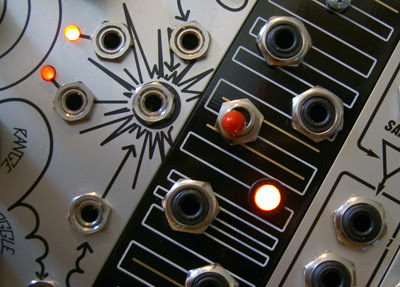via
Synthetic Sound Labs / SSL

"The Russians Are Coming!
What happens when you apply 1950's era Soviet technology to a modern analog synth? You get the new SSL 1530 Tube VCA / Timbral Gate module - a wild blend of vacuum tube warmth and distortion, along with an incredibly useful VCA that is so much more than the sum of its parts.
The 1530 uses miniature pencil-sized vacuum tubes that were developed and refined by the Russians over 60 years ago. They are exceptionally low current and low voltage devices - so there's no need to generate the traditional high-voltage power supplies that are required for most other vacuum tubes. Very cool stuff!
While it’s a surprisingly good VCA, it really shines when it’s over-driven - rounding and folding the input waveforms like nothing else available. In some modes, it’s prone to whacky self-oscillation that can be made to lock onto the harmonics of the input waveform in cascading howls. Totally adjustable and controllable.
In conjunction with and licensed by Ken Stone (CGS), Synthetic Sound Labs has further expanded on Ken's designs to include several other circuit enhancements to make your Russian dreams "Come True".
SSL has added LEDs behind the tube to visually emulate the warm glow of the filament, and pulsating blue LEDs that simulate tubes as they are being driven by control voltages. A custom acrylic window shows off the effects in true retro fashion.
SSL uses quality fiberglass-epoxy printed circuit boards, precision automated robotics and meticulous hand-crafted assembly assure years of trouble-free service.
Synthetic Sound Labs has been in the analog synthesizer business since 1973. The 1530 is yet another in SSL’s growing line of new synthesizer modules. Proudly made in the USA.
Pricing is $295 US. Available directly from SSL and through NoiseBug, Pomona, CA.
1530 Specifications at a glance:
Model
1530 Tube VCA / Timbral Gate
Function
Tube VCA / Timbral Gate - MU format Module
Controls
- DRIVE 1 – Drive 1 attenuator
- DRIVE 2 / FB – Drive 2 and normalized feedback attenuator
- INIT GAIN – Manual CV gain input
- CV AMT – CV Input gain attenuator
Switches (x2)
- FeedBack (On/Off)
- Bias (Dist/Clean)
Inputs
- DRIVE 1 – Variable gain Signal input
- DRIVE 2/FB – Variable gain Signal input – Input switch selectable feedback from output
- CV IN – Controls output gain. Attenuation control
Outputs
- OUT – Audio Output (AC Coupled)
Panel
High quality 0.062” aluminum. Durable black Metalphoto finish with natural aluminum graphics.
Power
- Current draw: +15V @ 30 ma. and -15V @ 22 ma.
- Synthesizers.com 6 pin Molex standard.
Size
8.75” H x 2.125” W x ~1.25” D (1 Moog Unit / MU)"
 flickr by kay_wrad
flickr by kay_wrad


























































